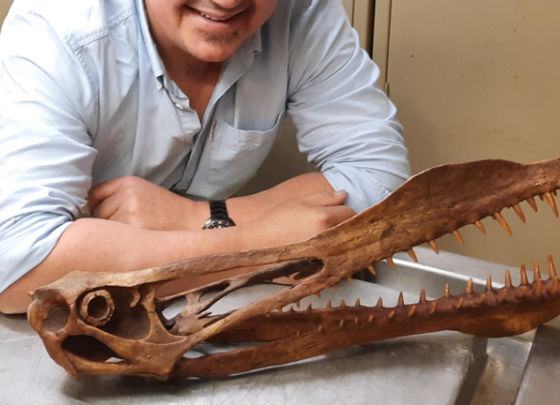SYDNEY – Paleontologists have identified the remains of Australia’s largest flying reptile that long ago soared above a vast inland sea, according to research revealed on Tuesday.
With a wingspan of about 7 meters, the pterosaur was described by researchers as a “fearsome beast with a spear-like mouth”.
Tim Richards, from the University of Queensland’s Dinosaur Lab, led a research team that analyzed the fossilized jaw of a pterosaur, which was discovered in Wanamara Country in the state of Queensland. Richards said it was “essentially just a skull with a long neck, bolted on a pair of long wings”.
He said that the creature, which was the “closest thing we have to a real-life dragon”, had ruled the skies about 105 million years ago.
“It would have cast a great shadow over some quivering little dinosaur that wouldn’t have heard it until it was too late,” he said.
In a research paper published in the Journal of Vertebrate Paleontology, the scientists noted that the skull, which is just over a meter long, contains about 40 teeth that would have made it perfectly suited to grasp the many fishes which inhabited the Eromanga Sea.
“Pterosaurs were a successful and diverse group of reptiles-the very first back-boned animals to take a stab at powered flight,” Richards said.
The prehistoric reptiles had thin-walled and relatively hollow bones, which meant their fossilized remains were rare and often poorly preserved.
“It’s quite amazing fossils of these animals exist at all,” he said.
Flight dynamics
Steve Salisbury, who co-wrote the research paper, said what was particularly striking about the new species was the massive size of the bony crest on its lower jaw, which it presumably also had on the upper jaw.
“These crests probably played a role in the flight dynamics of these creatures, and hopefully future research will deliver more definitive answers,” Salisbury said.
The fossil was actually found in a quarry about 10 years ago by fossicker Len Shaw, who had been “scratching around” the area for decades.
However, its significance had not been appreciated until Richards and his team began their investigation.
The scientists have called the discovery Thapunngaka shawi, which combines ancient aboriginal words meaning “spear” and “mouth”, while shawi is in recognition of the fossicker.
“So, the name means ‘Shaw’s spear mouth’,” Salisbury said.



